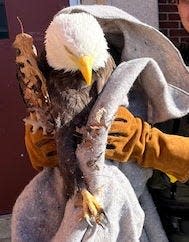What killed Cranston bald eagle? Wildlife rehabilitator thinks rat poison is killing raptors
CRANSTON – Laura Evans knew the bald eagle she picked up at a Cranston school wasn't doing well as she drove it toward Providence.
Evans is a state environmental police officer, and she had been dispatched to Sanders Academy, on Norwood Avenue, for a report of an injured bird.
"It was just lying face down in the corner at the entrance to the school," Evans told The Providence Journal Wednesday. "He was weak and didn't try to fight back."
This was her third call in the last year for an injured bird, but the first eagle she had to handle. "It was insane," she said. "They're huge." This bird was 13.5 pounds, more than 70 times heavier than a robin.
Evans wrapped the eagle in a blanket, placed it in a bin and drove toward Congress of the Birds, the Providence clinic run by Sheida Soleimani, a federally licensed wildlife rehabilitator.
Almost as soon as Evans walked in the door, the eagle started wheezing, she said.

Disease or poison? What is killing Rhode Island's raptors?
Lately, Soleimani has seen too many raptors – large birds that prey on smaller animals – that have been sickened by rat poison. Rats that eat the poison become lethargic, making them easy prey. When raptors eat rodenticide-laced rats, the poison can cause neurological symptoms and uncontrolled bleeding.
"Whether you like rats or not, these move up the food chain," said Soleimani. "It's a huge problem in the city of Cranston. These bait boxes are poisoning and killing raptors."
While it's also a problem in other Rhode Island cities, including Providence and Warwick – even the suburb of Johnston – the secondhand poisoning of raptors stands out in Cranston because Garden City has a higher eagle population, she said.
The eagle from Sanders Academy was negative in a preliminary test for avian flu, making rat poison the likely cause of its illness, Soleimani said.
More: Rat poisons are killing New England eagles and owls. How you can help save them
Not long after Evans handed the eagle off, it died in the rehabilitator's arms.
A necropsy – the animal equivalent of an autopsy – will be performed to check for poison.
Soleimani said the eagle had reached adulthood, making it about five years old, because the feathers on its head had turned white. She said it was probably male, based on its size – male bald eagles are smaller than females – but genetic testing would be needed to confirm that.
Eagle headed for special disposition
The federal Bald and Golden Eagle Protection Act of 1940 bans the possession of eagles and eagle parts, including feathers, except in certain circumstances. Under federal regulations, American Indian tribes, because of the cultural and religious significance of eagles to them, are one of those exceptions.
Soleimani said the eagle's carcass will be donated to the Narragansetts, the Wampanoags or the Abenakis after the necropsy is performed.
What's being done to stop the poisoning of raptors?
A bill is pending in the state House of Representatives that would ban one type of poison that is used to control rat populations, called second-generation anticoagulant rodenticides.
Soleimani testified at an April 4 hearing on the bill before the House Environment and Natural Resources Committee. After the hearing, the committee voted to hold the bill for further study.
Soleimani told The Journal on Wednesday that other effective rodenticides are available, including some that render rats sterile.
This article originally appeared on The Providence Journal: Why wildlife rehabilitator thinks rat poison is killing RI raptors
